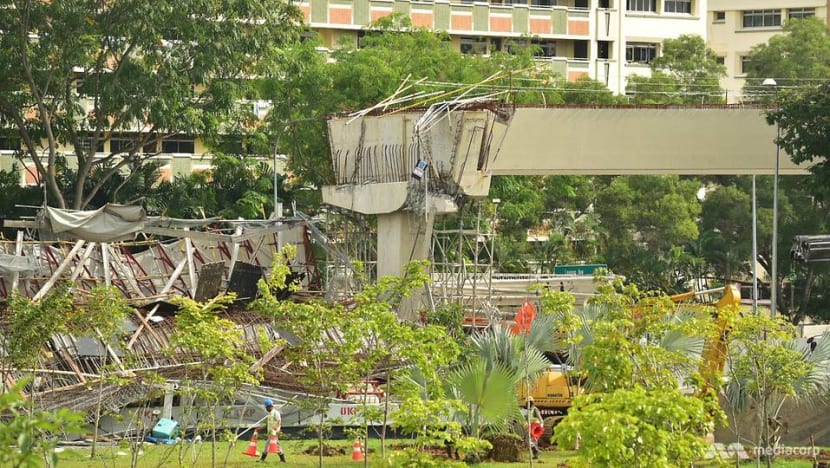PIE viaduct collapse: Engineer admits he knew about design errors, structural cracks before fatal accident

An uncompleted viaduct near the Pan-Island Expressway (PIE) collapsed on Jul 14, 2017. (Photo: Gaya Chandramohan)
SINGAPORE: Although he knew about errors in design and structural cracks in the building of a viaduct, an engineer tasked with preparing the building works and supervising them did not take necessary action.
A section of the viaduct from Tampines Expressway to Pan-Island Expressway and Upper Changi Road collapsed in the early hours of Jul 14, 2017, while workers were casting the concrete deck slab between two piers.
READ: PIE viaduct trial: Cracks spotted 3 times before collapse, builder unaware of errors in initial design
READ: PIE viaduct collapse: Builder Or Kim Peow Contractors fined for carrying out unapproved building works
Eleven workers on top of the structure fell with the steel bars, concrete and wooden slats. One worker died and the rest sustained various degrees of injuries.
After the collapse, engineer Robert Arianto Tjandra, 46, confided in a member of his team that the collapse was "obviously a design mistake".
Tjandra pleaded guilty on Wednesday (Nov 20) to three charges of recklessly doing an act endangering the safety of others at work, failing to take all reasonable steps and exercise due diligence to ensure building works were in line with regulations, and authorising building works to be carried out without approval.
Two other charges of making a false certification that plans and design calculations were prepared in accordance with regulations and failing to notify the commissioner of building control that he had contravened the Building Control Act will be taken into consideration for sentencing.
Tjandra pleaded guilty midway through a trial. He had been charged over the case along with four other individuals and construction company Or Kim Peow Contractors (OKP), which was fined S$10,000 in July for carrying out unapproved works.
The Land Transport Authority (LTA) had awarded the contract to OKP to design and build the 1.8km-long viaduct.
OKP engaged CPG Consultants, Tjandra's company, to act as the design consultant for the project.
Tjandra, a professional engineer, was the qualified person appointed to prepare the building works for the project, as well as to supervise the carrying out of the building works, a role he was appointed to as per a contract between LTA and CPG.
Two weeks before the collapse, Tjandra discovered errors in the design of the corbels and support structures meant to distribute the vehicular load.
He learnt of structural cracks on the crossheads of numerous constructed piers, including Piers 40 and 41, where the collapse later occurred.
READ: PIE viaduct collapse: Builder Or Kim Peow Contractors fined for carrying out unapproved building works
READ: Contractor in fatal viaduct collapse won bid with low safety score, lowest tender price, says MOT
These were signs of structural weakness, said the prosecution, and these signs led Tjandra to discover that wrong effective width assumptions had been used in the design of both temporary and permanent corbels of the viaduct, through his omissions at the design stage.
As a result, many of the corbels had insufficient capacity to support the loads they were intended to bear.
Tjandra also became aware that based on the correct structural design analysis, the temporary corbels at piers 40 and 41 were inadequate to support the additional weight from the deck slab scheduled to be cast.
Despite knowing about the risk of corbel failure during construction, Tjandra "recklessly failed to take the necessary measures" to ensure that the corbels in question would have the sufficient capacity to support the loads involved during the deck slab casting on Jul 14, 2017.
He also failed to ensure that the permanent corbels at other piers were designed in accordance with performance requirements such that combined loads could be sustained and transmitted safely to the ground.
Among other omissions at the design stage, Tjandra failed to properly examine the design calculations and rebar provisions for the permanent corbels.
These had been designed using wrong effective width assumptions and had insufficient capacity to sustain the loads when the viaduct was in service.
Not only did Tjandra fail in these aspects, he made false certifications in applications for the approval of structural plans, claiming that the plains and design calculations had been prepared in accordance with the Building Control Act and the Building Control Regulations.
When he became aware that the permanent corbels did not satisfy prescribed performance requirements, he did not notify the commissioner.
"Instead of complying with these statutory reporting requirements, the accused chose not to raise the alarm," said Deputy Public Prosecutors Kristy Tan, Yang Ziliang, Kelly Ho, Ho Lian-Yi, Ho Jiayun and Mark Yeo.
"Without seeking prior approval from the commissioner, he authorised works that deviated from the approved building plans by adding rebars to the constructed permanent corbel at pier 36."
The prosecutors on Wednesday asked the court to impose a jail term of at least 22 months and a fine of at least S$10,000.














